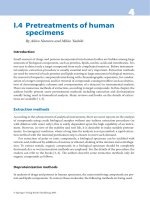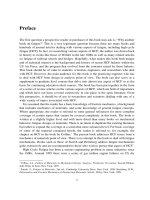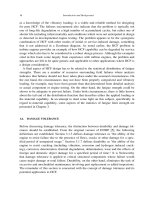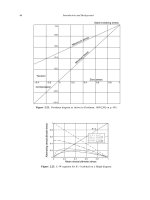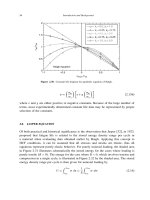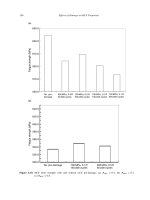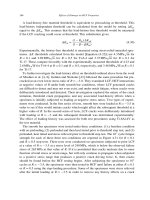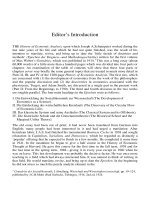A History of Vascular Surgery - part 4 pps
Bạn đang xem bản rút gọn của tài liệu. Xem và tải ngay bản đầy đủ của tài liệu tại đây (490.74 KB, 24 trang )
several contributions from other fields of science. In 1896, Wilhelm Konrad
Roentgen reported his discovery of x-rays in Nature; 3 months later Haschek and
Lindenthal performed the first arteriogram. They injected a radiopaque mixture
into the arteries of an amputated arm to test Roentgen’s discovery.
In 1918, Cameron reported the use of iodized salts as a contrast medium, and
several years later Sicard and Forestier developed an iodized poppyseed oil
called lipiodol. Sicard and Forestier performed the first clinical arteriogram
when they injected their solution into the antecubital veins of a patient and
observed its passage to the lungs fluoroscopically.
In 1924, Barney Brooks used injections of sodium iodide to study the arterial
anatomy of the lower extremity. Great progress in arteriography was also made
in Portugal, where the technique of cerebral angiography was introduced in
Development of the venous autograft 59
Figure 6.6 Erich Lexer (from Harrison LH Jr. Historical aspects in the development of venous
autografts. Ann Surg 1976; 183:101).
1927 by Egas Moniz. Two years later, Reynaldo Dos Santos reported angiogra-
phy of the abdominal aorta, its branches, and the lower extremities (Figures 6.8
and 6.9). An accurate diagnostic procedure for vascular lesions was now avail-
able.
Little progress in vascular surgery resulted from the carnage of World War I,
apart from the contributions of several German surgeons that went unnoticed.
As early as 1913, Ernest Jaeger had advocated the principle of maintaining arte-
rial continuity with various grafts, in the management of traumatic pseudo-
60 Chapter 6
Figure 6.7 Bertram Bernheim (from Harrison LH Jr. Historical aspects in the development of
venous autografts. Ann Surg 1976; 183:101).
aneurysms. He later experimented with fresh venous and arterial homografts
from limbs that had been severed in battle.
Warthmuller reported an 85 percent success rate in 47 cases of vein grafting
for traumatic aneurysms in 1917.
Following the war, reviews by Weglowski and Lexer described 51 and 58
cases, respectively, of venous autografts for pseudoaneurysms. Lexer had one of
the largest personal experiences, with 13 cases.
An important obstacle that needed to be overcome before the technique of
bypass grafting could gain wider use was the problem of thrombosis. Heparin
was discovered in 1916 by Jay McLean, a medical student working in the labora-
tory of W.H. Howell. The discovery was reported in 1918, but heparin remained
too toxic for clinical use.
Best and Scott described the purification of heparin in 1933, and 5 years later
Development of the venous autograft 61
Figure 6.8 Reynaldo Dos Santos (from Callow AD. Historical development of vascular grafts. In:
Sawyer PN, Kaplitt MJ, eds. Vascular Grafts. New York: Appleton-Century-Crofts, 1978).
Murray and Best demonstrated that it could prevent thrombosis along suture
lines in arteries and venous grafts.
In 1940, Murray summarized the clinical use of heparin, concluding that it
was an important agent for prevention of thrombosis during repair of blood ves-
sels, and was valuable in disease states that might promote venous thrombosis
(Figure 6.10).
Realization of the great potential value of heparin led to another landmark
contribution to vascular surgery: thromboendarterectomy. The early attempts
at this procedure by Severeanu in 1880 and Jianu in 1909 were unsuccessful
62 Chapter 6
Figure 6.9 Early angiogram performed by Reynaldo Dos Santos (from Dos Santos R, Lamas A,
Pereigi CJ. L’artériographie des membres de l’aorte et ses branches abdominales. Bull Soc Nat
Chir 1929; 55:587).
because of thrombosis. Delbet also attempted thromboendarterectomy in 1906
and, despite his failure, concluded that:
The easiest operation that can be done to cure arterial obstruction is incision of the
artery, extraction of the thrombus and closure of the vessel.
Nevertheless, the procedure was abandoned by surgeons until 1946. Joao
Cid Dos Santos (son of Reynaldo), with 3 years of vascular surgical experience
with the use of heparin under his belt, conceived the following idea:
Exactly what I had in mind was to find the plane of cleavage between the old thrombus
and the intima, leaving a devastated initial wall to be coated by newly built
endothelium while anticoagulation was active.
Dos Santos’s first patient was a 66-year-old man with end-stage renal failure
and a threatened left lower extremity secondary to an iliac–femoral occlusion.
On August 27, 1946, Dos Santos performed the first successful thromboend-
arterectomy with a silver ophthalmic spatula and a gallstone scoop. The post-
Development of the venous autograft 63
Figure 6.10 Murray’s illustration of venous transplantation with the use of heparin (from Murray G.
Heparin in surgical treatment of blood vessels. Arch Surg 1940; 40:307).
operative angiogram revealed patency of the iliac and femoral arteries (Figure
6.11). The patient died of uremia 2 days later. A second arteriogram performed
prior to the autopsy also confirmed arterial patency.
Four months later, Dos Santos saw a 35-year-old woman with ischemia of the
right upper extremity caused by occlusion of the subclavian artery. Using the
same instruments, a successful thromboendarterectomy was performed again.
In 1975, 22 years later, Dos Santos confirmed continued patency of the subcla-
vian artery in his patient.
The significance of Dos Santos’s procedures was soon realized by other sur-
geons such as Bazy in France and Wylie and Freeman in the United States. As a
result of their work, thromboendarterectomy became a basic technique in the
repertoire of every vascular surgeon.
It is ironic that World War II produced fewer contributions to vascular sur-
gery than World War I. In their review of 2471 acute arterial injuries during the
war, DeBakey and Simeone identified only 40 cases of repair with vein grafts, re-
sulting in a 58 percent amputation rate. They concluded that the indications for
reconstruction of acute arterial injuries with venous grafts were few.
The story of the venous autograft resumes in Paris. Although initially advo-
cated by Jaeger in 1913, Jean Kunlin revived the technique of bypass grafting in
64 Chapter 6
Figure 6.11 Joao Cid Dos Santos describes his concept of thromboendarterectomy (from
Haimovici H. Matas Lecture: The early pioneers in vascular surgery and their legacy. J Cardiovasc
Surg 1984; 25:275; reprinted by permission).
1948 (see Figure 19.1). His patient was a 54-year-old man on Leriche’s service,
who, despite a lumbar symphathectomy, a femoral arteriectomy, and a great toe
amputation, was still suffering with painful gangrenous ulcers. On June 3,
Kunlin harvested a 26-cm length of greater saphenous vein and, because of scar-
ring from prior surgery, performed proximal and distal end-to-end anasto-
moses between the femoral and popliteal arteries. The concept of an end-to-side
anastomosis was a new and important one, as side branches between the anas-
tomoses could now be preserved. The results were dramatic, with healing of the
ulcers and resumption of painless walking by the patient. In 1951, Kunlin re-
ported 17 cases of autogenous venous bypasses (see Figure 19.2).
Six months after Kunlin’s historic operation, the first successful bypass was
performed in the United States by William Holden. His patient was also a young
man with lower extremity ischemia of 5 years’ duration. The favorable results of
Holden’s procedure led him to conclude that, despite its appearance as a “radi-
cal form of therapy,” the alternative of amputation was also radical. He sum-
marized the sentiments of most present-day vascular surgeons with his final
comment:
There are many factors which may jeopardize the success of this procedure, and it is to
be hoped that with patience and application they may be eliminated.
In his analysis of 304 vascular injuries during the Korean War, Hughes found
34 cases of autogenous vein graft use, resulting in a limb salvage rate close to 90
percent. Continued evaluation of venous grafts for the treatment of arterial
injuries was continued by Rich during the Vietnam War with similar excellent
results.
Wider acceptance of the principles of arterial reconstruction continued in
civilian practice. In 1951, Fontaine reported 28 cases of venous autografts, with
patency of 10 during the follow-up of nearly 1 year.
This procedure was favorably received in the United States, and in 1952 Ju-
lian reported 19 cases of bypass grafts with success in 12. Other early series in-
cluded those of Lord and Stone, who reported 21 autogenous vein grafts in 1957;
Dale and DeWeese, who analyzed 31 cases in 1959; and Linton and Darling, who
reported on 76 consecutive saphenous vein bypass grafts in 1962.
The efficacy of autogenous venous conduits in the arterial system was estab-
lished by the end of the 1950s. At that time, several surgeons were contemplat-
ing ways to make the procedure faster by leaving the saphenous vein in situ. This
idea occurred simultaneously in two different centers in 1959. Paul Cartier of
Montreal and Karl Hall, while working with Charles Rob in St Mary’s Hospital
in London, began the first clinical trials of in situ vein bypass (Figures 6.12–6.14).
Cartier employed a retrograde valve stripper while Hall, after several unsuc-
cessful cases with a blunt vein stripper introduced antegrade, resorted, upon his
return to Norway, to direct excision of the valve cusps. Because this was such a
long and tedious procedure, Hall developed his own retrograde valve stripper
in 1968. He reported his results in 1978 with the original technique in 252 cases
(Figure 6.15). By 1984, Cartier had performed over 850 in situ bypasses with a 75
percent 5-year patency rate.
Development of the venous autograft 65
While Cartier and Hall were perfecting their techniques, several discourag-
ing reports of in situ vein bypass appeared in the United States. Darling, May,
Barner, and others concluded that the in situ technique offered no advantage
over the reversed technique. The failures with this procedure were primarily
due to ineffective or overly traumatic methods of valve disruption. Conse-
quently, the procedure fell into disfavor for nearly a decade until Leather re-
ported excellent results utilizing “a simplified atraumatic method of rendering
the valves incompetent” in 1979. Since then, the in situ technique has enjoyed
a revival and is the preferred method of venous grafting in many centers.
66 Chapter 6
Figure 6.12 Paul Cartier (courtesy of Dr. Paul Cartier).
Impressed by the work of Karl Hall, Leather reasoned that a simplified atrau-
matic method of rendering the saphenous vein valves incompetent could pro-
duce better results. He used specially designed microvascular scissors to excise
valve leaflets through convenient side branches. Leather reported cumulative
patency rates of 91 percent at 12 and 24 months in the initial 89 in situ bypasses
performed in this manner. He proposed that this technique would allow utiliza-
Development of the venous autograft 67
Figure 6.13 Charles Rob (courtesy of Dr. Charles Rob).
tion of veins that were too small for excision and reversal, and that this tech-
nique was the superior of the two.
Leather and his coworkers eventually reported long-term results of 2058 in
situ vein bypasses performed over a 20-year period (1975–1995). The indication
for surgery was limb-threatening ischemia in 91 percent of their patients. The
cumulative secondary patency rates were 91 percent, 81 percent, and 70 percent
after 1, 5, and 10 years respectively. The limb salvage rates at these intervals were
68 Chapter 6
Figure 6.14 Karl Victor Hall (courtesy of Dr. Karl V. Hall).
Development of the venous autograft 69
Figure 6.15 Hall’s illustration and description of his technique for in situ vein bypass (from Hall KV.
The great saphenous vein used “in-situ” as an arterial shunt after extirpation of the vein valves.
Surgery 1962; 51:492).
97 percent, 95 percent, and 90 percent respectively. The authors concluded that
the in situ saphenous vein was an excellent conduit for limb salvage bypasses.
As surgeons are wont to do, many took sides in the debate over which tech-
nique was superior. Stating the case for reversed veins in 1990, Taylor reported
the results of a “modern series” of 516 reversed vein bypasses in 387 patients.
The indication for surgery was limb salvage in 80 percent of patients, and only
55 percent of limbs possessed adequate ipsilateral saphenous vein. The primary
and secondary patency rates for all grafts after 5 years were 75 percent and 81
percent respectively. Taylor preferred the reversed vein technique owing to the
excellent patency rates and the value of this procedure in the large number of
patients without ipsilateral greater saphenous vein.
One year later, Donaldson provided counterpoise with a report of 440 con-
secutive in situ saphenous vein bypasses in 371 patients, performed during a 7-
year period. Limb-threatening ischemia was the indication for surgery in 68
percent of cases. The 5-year secondary patency rate was 83 percent, with an 88
percent limb salvage rate. Based on these results, and the versatility and sim-
plicity of the in situ technique, Donaldson concluded that it was the procedure of
choice for long infrapopliteal bypasses.
In 1992, Rosenthal described a preliminary multicenter report of endovascu-
lar in situ saphenous vein bypass. Valvulotomy was accomplished with a long
retrograde valvulotome, and steerable nitinol catheters were used to coil em-
bolize saphenous vein branches, all under angioscopic surveillance. The appeal
of this procedure was avoiding long leg incisions, reducing wound complica-
tions, and reducing hospital stays. Eight years later, he reported favorable cu-
mulative patency, limb salvage, and cost results with this technique after a mean
follow-up of 16.6 months.
Voices of reason in this debate took the form of several prospective random-
ized comparisons of the two techniques, each of which found no significant
differences between the two. In one multicenter trial, 125 patients were random-
ized to receive reversed vein or in situ bypasses. After 2.5 years, there was no sig-
nificant difference in patency rates for the two graft types. The authors of this
study noted relative advantages of both techniques and concluded, most im-
portantly: “. . . surgeons performing these operations should be adept at both
procedures.”
Bibliography
Barner HB, Judd DR, Kaiser GC, et al. Late failure of arterialized in situ saphenous vein. Arch
Surg 1969; 99:781.
Bazy L, Huguier J, Reboul H, et al. Technique des “endarterectomies” pour arterites
oblitérantes chroniques des membres inférieurs. J Chir (Paris) 1949; 65:196.
Bernheim BM. Surgery of the Vascular System. Philadelphia: JB Lippincott Co., 1913.
Bernheim BM. The ideal operation for aneurysm of the extremity. Report of a case. Bull Johns
Hopkins Hosp 1916; 27:93.
Best CH, Scott C. The purification of heparin. J Biol Chem 1933; 102:425.
70 Chapter 6
Brooks B. Injection of sodium iodide. JAMA 1924; 82:1016.
Cameron DF. Aqueous solutions of potassium and sodium iodide as opaque medium in
roentgenography. JAMA 1918; 70:754.
Carrel A. La technique opératoire des anastamoses vasculaires et la transplantation des
viscères. Lyon Med 1902; 98:859.
Carrel A. The surgery of blood vessels, etc. Bull Johns Hopkins Hosp 1907; 190:18.
Carrel A, Guthrie CC. Results of biterminal transplantation of veins. Am J Med Sci 1906; 132:
415.
Carrel A, Guthrie CC. Uniterminal and biterminal venous transplantation. Surg Gynecol Obstet
1906; 2:266.
Carrel A, Morel A. Anastamose bout à bout de la jugulaire et de la carotide primitive. Lyon Med
1902; 99:114.
Dale WA. Management of Vascular Surgical Problems. New York: McGraw Hill, 1985.
Dale WA, DeWeese JA, Merle Scott WJ. Autogenous venous shunt grafts. Rationale and report
of 31 for atherosclerosis. Surgery 1959; 46:145.
Darling RC, Linton RR, Razzuk MA. Saphenous vein bypass grafts for femoropopliteal occlu-
sive disease: Areappraisal. Surgery 1967; 31:61.
DeBakey ME, Simeone FA. Battle injuries of the arteries in WW II. An analysis of 2471 cases. Ann
Surg 1946; 123:534.
Delbet P. Chirurgie artérielle et veineuse. Les modernes acquisitions. Paris: JB Bailliere et Fils, 1906.
Donaldson MC, Whittemore AD, Mannick JA. Femoral-distal bypass with in situ greater
saphenous vein. Long-term results using the Mills valvulotome. Ann Surg 1991; 213:457.
Donaldson MC, Whittemore AD, Mannick JA. Further experience with an all-autogenous
tissue policy for infrainguinal reconstruction. J Vasc Surg 1993; 18:41.
Dos Santos JC. Leriche memorial lecture. From embolectomy to endarterectomy or the fall of
myth. J Cardiovasc Surg 1976; 17:113.
Dos Santos R, Lamas A, Pereirgi CJ. L’artériographie des membres de l’aorte et ses branches
abdominales. Bull Soc Nat Chir 1929; 55:587.
Exner A. Einige tierversuche ueber vereinigung und transplantation von blutgefaessen. Wien
Klin Wschr 1903; 16:273.
Fogle MA, Whittemore AD, Couch NP, et al. Acomparison of in situ and reversed saphenous
vein grafts for infrainguinal reconstruction. J Vasc Surg 1987; 5:46.
Fontaine R, Buck P, Riveaux R, et al. Treatment of arterial occlusion, comparative value of
thrombectomy, thromboendarterectomy, arteriovenous shunt and vascular grafts (fresh
venous autografts). Lyon Chir 1951; 46:73.
Freeman NE, Gilfillan RS. Regional heparinization after thromboendarterectomy in the treat-
ment of obliterative arterial disease: Preliminary report based on 12 cases. Surgery 1952;
31:115.
Gluck T. Die moderne chirurgie des circulationapparats. Berl Klin 1898; 70:1.
Goyanes J. Nuevos trabajos de cirugia vascular. Substitucion plastica de las arterias por las
venas, o arterioplastia venosa, applicada, como nuevo metodo, al tratamiento de los
aneurismas. El Siglo Med 1906; Sept:346, 561.
Hall KV. The great saphenous vein used “in-situ” as an arterial shunt after extirpation of the
vein valves. Surgery 1962; 51:492.
Hall KV. The saphenous vein used “in-situ” as an arterial bupass. Am J Surg 1978; 136:123.
Harris PL, How TV, Jones DR. Prospectively randomized clinical trial to compare in situ and
reversed saphenous vein grafts for femoropopliteal bypass. Br J Surg 1987; 74:252.
Harrison LH Jr. Historical aspects in the development of venous autografts. Ann Surg 1976;
183:101.
Development of the venous autograft 71
Haschek E, Lindenthal OT. Ein beitrag zur praktischen verwerthung der photographie nach
Roentgen. Wien Klin Wochenschr 1896; 9:63.
Hoepfner E. Ueber gefaessnaht, gefaesstransplantation und replantation von amputierten
extremitaeten. Arch Klin Chir 1903; 70:417.
Holden WD. Reconstruction of the femoral artery for arteriosclerotic thrombosis. Surgery 1950;
27:417.
Howell WH. Two new factors in blood coagulation – heparin and proantithrombin. Am J
Physiol 1918; 47:328.
Hughes CW. Arterial repair during the Korean War. Ann Surg 1958; 147:555.
Jaeger E. Die Chirurgie der Blutgefaesse und des Herzens. Berlin: AHirsrchwald, 1913.
Jaeger E. Zur technik der blutgefaessnaht. Beitr Klin Chir 1915; 97:553.
Jianu I. Trombectomia arteriala pentru un caz de gangrena uscata a piciorului. Soc Chir
(Bucarest) 1912; 27:11.
Julian OC, Dye WS, Olwin JH. Direct surgery of arteriosclerosis. Ann Surg 1952; 136:459.
Kunlin J. Le traitement de l’artérite obliterante par la greffe veineuse. Arch Mal Coeur 1949;
42:371.
Kunlin J. Le traitement de l’ischemie artéritique par la greffe veineuse longue. Rev Chir 1951;
70:206.
Leather RP, Powers SR Jr., Karmody AM. The reappraisal of the in situ saphenous vein arterial
bypass: Its use in limb salvage. Surgery 1979; 86:453.
Lexer E. Die ideale operation des arteriellen und des arteriellvenoesen aneurysma. Arch Klin
Chir 1907; 83:459.
Lexer E. Zwanzig jahre transplantationsforschung in der chirurgie. Arch Klin Chir 1925;
138:251.
Linton RR, Darling RC. Autogenous saphenous vein bypass grafts in femoropopliteal oblitera-
tive arterial disease. Surgery 1962; 51:62.
Lord JW, Stone DW. The use of autologous venous grafts in the peripheral arterial system. Arch
Surg 1957; 74:71.
MacLean J. The thromboplastic action of cephalin. Am J Physiol 1916; 41:250.
May AG, DeWeese JA, Rob CG. Arteialized in situ saphenous vein. Arch Surg 1965; 91:743.
Moniz E. L’éncephalographie artérielle son importance dans la localisation des tumeurs
cérébrales. Rev Neurol 1927; 2:72.
Moody AP, Edwards PR, Harris PL. In situ versus reversed femoropopliteal vein grafts: long-
term follow-up of a prospective, randomized trial. Br J Surg 1992; 79:750.
Murray G. Heparin in surgical treatment of blood vessels. Arch Surg 1940; 40:307.
Payr E. Weitere mittheilungen ueber verwendung des magnesiums bei der naht der blutge-
faesse. Arch Klin Chir 1901; 64:726.
Porter JM. In situ versus reversed vein graft: Is one superior. J Vasc Surg 1987; 5:779.
Pringle H. Two cases of vein grafting for the maintenance of direct arterial circulation. Lancet
1913; 1:1795.
Rich NM. Vascular trauma in Vietnam. J Cardiovasc Surg 1970; 11:368.
Roentgen WK. Ueber sine neue art von Strahlen (trans). Nature 1896; 53:274.
Rosenthal D, Herring MB, O’Donovan TG, et al. Endovascular infrainguinal in situ saphenous
vein bypass: Amulticenter preliminary report. J Vasc Surg 1992; 16:453.
Rosenthal D, Arous EJ, Friedman SG, et al. Endovascular-assisted versus conventional in situ
saphenous vein bypass grafting: Cumulative patency, limb salvage, and cost results in a
39-month multicenter study. J Vasc Surg 2000; 31:60.
Shah DM, Darlin, RC III, Chang BB, et al. Long-term results of in situ vein bypass. Analysis of
2058 cases. Ann Surg 1995; 222:438.
72 Chapter 6
Sicard A, Forestier J. L’huile iodée en clinique; applications thérapeutiques et diagnostiques.
Bull Mem Hosp Paris 1923; 47:309.
Stich R, Makkas M, Dowman CE. Beitrage zur gefaesschirurgie; cirkulaere arteriennaht und
gefaesstransplantationen. Beitr Klin Chir 1907; 53:113.
Taylor LM Jr., Edwards JM, Phinney ES, et al. Reversed vein bypass to infrapopliteal arteries.
Modern results are superior to or equivalent to in situ bypass for patency and for vein
utilization. Ann Surg 1987; 205:90.
Taylor LM Jr., Edwards JM, Porter JM. Present status of reversed vein bypass grafting: Five year
results of a modern series. J Vasc Surg 1990; 11:193.
Warthmuller H. Ueber die bisherigen erfolge der gefaesstransplantation am menschen. Dis G
Neuenbann Jena 1917.
Weglowski R. Ueber die gefaesstransplantation. Zentr Chir 1925; 52:441.
Wengerter KR, Veith FJ, Gupta SK, et al. Prospective randomized multicenter comparison of in
situ and reversed vein infrapopliteal bypasses. J Vasc Surg 1991; 13:189.
Wylie EJ. Thromboendarterectomy for arteriosclerotic thrombosis of major arteries. Surgery
1952; 32:275.
Development of the venous autograft 73
CHAPTER 7
Evolution of aortic surgery
74
Life shrinks or expands in proportion to one’s courage.
(Anaïs Nin)
The original operations on the aorta were for the treatment of aneurysms.
Arterial reconstruction was an unknown concept until the 20th century, and lig-
ation of the aorta appeared to be the best treatment for these lesions. The first
case has already been described. It took place in 1817, when Astley Cooper
ligated the aortic bifurcation in a 38-year-old man for a ruptured left external
iliac aneurysm. Cooper performed the surgery while the patient was still in his
hospital bed. Although the first postoperative day passed smoothly, the patient
died on the second day following surgery.
The second case of aortic ligation was also performed for an aneurysm of the
left external iliac artery. It was undertaken in 1829, when J.H. James ligated the
aortic bifurcation in a 44-year-old man. His patient succumbed to shock 4 hours
after the surgery.
Prior to the turn of the 20th century, 10 additional cases of aortic ligation were
recorded. Most of these were for syphilitic aneurysms of the iliac arteries in
young men ranging in age from 28 to 52 years. In eight cases, the aortic bifurca-
tion was ligated, and in another case ligation was performed just below the renal
arteries. Most of these cases resulted in death from hemorrhagic shock within
hours. The longest survivor was a patient of Keen, who underwent aortic liga-
tion at the diaphragm for a ruptured abdominal aortic aneurysm in 1899. The
surgery was successful and the patient survived 48 days, at which time the
aortic ligature eroded into the vessel.
The first aortic ligation in the 20th century, by Tillaux, emphasized the pauc-
ity of progress since Cooper’s original procedure. Tillaux ligated the aortic bi-
furcation for a ruptured iliac aneurysm just as Cooper had done. His patient also
died within 2 days.
R.T. Morris introduced the first alteration of Cooper’s operation in 1901,
when he ligated the aortic bifurcation with a soft rubber catheter, hoping to pre-
vent erosion of the ligature into the vessel. His patient, a 24-year-old woman,
died 53 hours after the surgery, from ischemic bowel.
Between 1906 and 1911, William Halstead performed four aortic ligations
with aluminum bands, also in an attempt to prevent erosion (Figure 7.1). In one
case he performed partial ligation of the aorta, and his patient survived for 47
days. Sepsis resulting from an infected band was the cause of death. In one
of Halstead’s cases, the aneurysm ruptured 18 days after the surgery and in
another the band cut through the aorta after 6 weeks.
The thoracic aorta was not spared from attempts at ligation for aneurysm,
and it was Tuffier who attempted the first of these in 1902 (Figure 7.2). His oper-
ation was as daring as Cooper’s 85 years earlier. Tuffier’s patient had a saccular
aneurysm of the ascending aorta. Tuffier doubly ligated the neck of the
aneurysm with catgut suture and then attempted to dissect it free of surround-
ing structures to excise it. He abandoned this effort because of the size of the
aneurysm and his patient died of sudden hemorrhage on the 13th postoperative
day owing to necrosis of the sac. Three subsequent thoracic aortic ligations by
Tuffier were also unsuccessful.
In 1914, Kummell reported his attempt to treat a ruptured thoracic aneurysm
by oversewing the defect. Although the procedure took only 1 hour, the 52-year-
old patient soon “died of exhaustion.”
Evolution of aortic surgery 75
Figure 7.1 William Halstead (from Rutkow IM. The letters of William Halstead and Erwin Payr. Surg
Gynecol Obstet 1985; 161:75; reprinted by permission).
George Vaughan reported the first long-term success following partial aortic
occlusion for an aneurysm in 1921. His patient survived for 2 years and 1 month
following aortic ligation with cotton tape.
As previously noted, Rudolph Matas carried out the first successful ligation
of the aorta in April 1923, more than a century after Astley Cooper’s original at-
tempt (Figure 7.3). Matas’s patient was a 28-year-old female plantation worker
76 Chapter 7
Figure 7.2 Marin-Theodore Tuffier (from Garrison FH. History of Medicine. Philadelphia: WB
Saunders Co., 1929).
Evolution of aortic surgery 77
Figure 7.3 Matas’s successful ligation of the abdominal aorta (from Matas R. Aneurysm of the
abdominal aorta at its bifurcation into the common iliac arteries. A pictorial supplement illustrating
the history of Corrinne D, previously reported as the first recorded instance of cure of an aneurysm
of the abdominal aorta by ligation. Ann Surg 1940; 112:909).
with a ruptured syphilitic aneurysm of the aortic bifurcation and common iliac
arteries. Although Matas had previously experimented with introducing wire
into aneurysms to induce thrombosis, he used two cotton tapes to completely
ligate the abdominal aorta just above the sac. Matas’s patient survived for 17
months, then died of tuberculosis.
At this time, René Leriche (see Figure 18.1) was adding significant contribu-
tions to the already formidable list compiled by his predecessors Mathieu
Jaboulay and Alexis Carrel. Leriche originally popularized sympathectomy for
the treatment of arterial occlusive disease. He also attempted several autoge-
nous vein bypasses of occluded iliac segments unsuccessfully. Leriche is best
known for his description of “obliteration of the terminal abdominal aorta” in
1923. He anticipated the present treatment of this lesion when he wrote: “The
ideal treatment of arterial thrombosis is the replacement of the obliterated
segment with a vascular graft.”
Little progress in aortic surgery occurred during the two decades following
Matas’s historic operation. Scattered reports of successful aortic ligation ap-
peared in the literature, but surgeons remained hesitant to undertake this pro-
cedure. Bigger summarized the prevailing attitude when he addressed the
American Surgical Association in 1940:
Judging from the literature, only a small number of surgeons have felt that direct
surgical attack upon aneurysms of the abdominal aorta was justifiable, and it
must be admitted that the results obtained by surgical intervention have been
discouraging.
That many surgeons still feared direct surgical treatment of aortic aneurysms
was demonstrated by the resurrection of techniques to introduce foreign mate-
rial into them to promote thrombosis. The first attempt was by Alfred Velpeau in
1831, with three pairs of sewing needles being introduced (Figure 7.4). Moore
used 26 yards of iron wire in 1865, and Corradi modified this technique in 1879
by passing an electric current through the wire. Blakemore and King experi-
mented with this method in 1938. Cellophane wrapping was also investigated
by Pearse in 1940, and by Harrison 3 years later. Many other surgeons examined
these therapeutic alternatives.
Enthusiasm for aortic surgery was renewed in 1944 when Alexander and
Byron reported the first successful excision of an aortic aneurysm with proximal
and distal ligation (Figure 7.5). Their patient was a 19-year-old college student
with an 18-cm thoracic aneurysm. Except for persistent headaches and hyper-
tension, the patient made a good recovery and was discharged on the 37th post-
operative day.
In the case of Alexander’s patient, the aneurysm was due to coarctation
of the aorta. Surgical attempts at treating this lesion during the 1940s
played an important role in the development of aortic surgery and
heralded operations upon the aorta for lesions other than aneurysms. In 1944,
Blalock and Park hypothesized that the left subclavian artery could be
used to bypass a coarctation, but it was Clarence Crafoord of Sweden
who performed the first successful correction of this condition
78 Chapter 7
(Figure 7.6). On October 19 and 31, 1944, Crafoord resected coarctations in a 12-
year-old schoolboy and a 27-year-old farmer respectively. In each case the aorta
was repaired by end-to-end anastomosis using the triangulation technique of
Carrel. Both patients made excellent recoveries following brief respiratory tract
infections.
Evolution of aortic surgery 79
Figure 7.4 Alfred Armand Louis Marie Velpeau (from Major RA. A History of Medicine. Springfield,
IL: Charles C Thomas, 1954).
In June 1945, Robert Gross repeated this procedure in the United States
(Figure 7.7). An end-to-end aortic anastomosis was also performed by Shu-
macker during the first successful aortic aneurysm resection with restoration of
arterial continuity in 1947 (Figure 7.8). Shumacker’s patient was an 8-year-old
boy with a thoracic aortic coarctation and a 4-cm aneurysm.
During the next few years, surgical correction of aortic coarctation was per-
formed in many centers throughout the world, with excellent results. This was
a critical period in aortic surgery as surgeons began to realize their ability to
clamp and suture the aorta without disrupting its integrity.
The next contribution to aortic surgery was made through efforts to recon-
struct the aorta when end-to-end anastomosis was not possible. Surgical
researchers had endeavored to find ways to successfully bridge large gaps
in arteries since the work of Abbe in 1894. Only after many years of experi-
mentation was it accepted that the use of rigid arterial prostheses was not
feasible.
The original experiments with implantation of preserved blood vessels were
performed by Carrel and Guthrie in Chicago. They replaced cat abdominal aor-
tas with canine veins and arteries that had been harvested several weeks earlier
and preserved near the freezing point of water in a salt solution. One of their het-
erografts remained patent for 77 days. Carrel continued this work following his
move to Rockefeller University.
The first successful operations for aortic coarctation brought about a
renewed interest in arterial homografts. Blakemore and Lord, Huffnagel, and
Pierce and Gross all studied the possibility of replacing human arteries with
those previously harvested and stored by a variety of methods.
In 1948, Gross reported the preliminary use of preserved arterial grafts in
humans with cyanotic heart disease and coarctation. That same year Swan used
80 Chapter 7
Figure 7.5 The operation of Alexander and Byron (from Alexander J, Byron FX. Aortectomy for
thoracic aneurysm. JAMA 1944; 126:1139).
an arterial homograft following resection of a thoracic aneurysm in a 16-year-
old boy. These initial successful treatments of aneurysms and coarctations
with homografts quickly led to their use in the treatment of aorto-iliac occlusive
disease.
The line of great French vascular surgeons was extended by Jacques
Evolution of aortic surgery 81
Figure 7.6 Clarence Crafoord (from Bjork VO. Clarence Crafoord (1900–1984) the leading
European thoracic surgeon died. J Cardiovasc Surg 1984; 25:473; reprinted by permission from
Appleton-Century-Crofts).
Oudot when he replaced a thrombosed aortic bifurcation with an arterial homo-
graft in November 1950. Following persistent ischemia of the right lower
extremity, he placed a second homograft from the left to the right external iliac
artery. The patient made an excellent recovery and over the next 2 years
Oudot performed four more aortic bifurcation resections with homograft
82 Chapter 7
Figure 7.7 Robert Gross (from Callow AD. Historical development of vascular grafts. In: Sawyer
PN, Kaplitt MJ, eds. Vascular Grafts. New York: Appleton-Century-Crofts, 1978).
